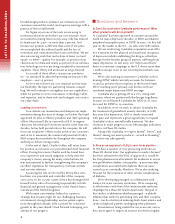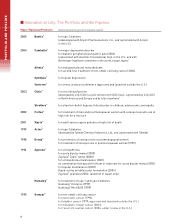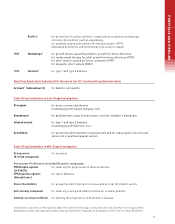Eli Lilly 2005 Annual Report Download - page 16
Download and view the complete annual report
Please find page 16 of the 2005 Eli Lilly annual report below. You can navigate through the pages in the report by either clicking on the pages listed below, or by using the keyword search tool below to find specific information within the annual report.
FI NA NCI A L S
14
Humatrope®, and Zyprexa.
•
We launched Cymbalta for the treatment of major de-
pressive disorder in the U.S. in August 2004. In Septem-
ber 2004, Cymbalta received its second U.S. approval
and became the first FDA-approved treatment for
diabetic peripheral neuropathic pain (DPNP). Cymbalta
was launched in the United Kingdom and Germany
in the first quarter of 2005 for the treatment of major
depressive episodes. Other launches in the European
Union are expected to occur throughout 2006. The Eu-
ropean Commission also granted marketing authoriza-
tion of Cymbalta for the treatment of DPNP in adults in
July 2005. Cymbalta has achieved $728.9 million in U.S.
sales since its launch.
• In June 2005, Lilly and Amylin Pharmaceuticals, Inc.,
launched Byetta (exenatide), the first in a new class of
medicines known as incretin mimetics, in the U.S. for
the treatment of type 2 diabetes. In the fourth quarter
of 2005, we submitted Byetta for the treatment of type
2 diabetes in Europe.
• We expect to advance our pipeline during 2006 with
three significant submissions anticipated, including
Arxxant™ for diabetic retinopathy, Cymbalta for gen-
eralized anxiety disorder, and Evista for breast cancer
risk reduction in postmenopausal women.
Legal and Governmental Matters
Certain generic manufacturers have challenged our U.S.
compound patent for Zyprexa and are seeking permission
to market generic versions of Zyprexa prior to its pat-
ent expiration in 2011. On April 14, 2005, the U.S. District
Court in Indianapolis ruled in our favor on all counts,
upholding our patents. The decision has been appealed.
In 2005, we entered into an agreement with plain-
tiffs’ attorneys involved in certain U.S. Zyprexa prod-
uct liability litigation to settle a majority of the claims
against us relating to the medication. We established
a fund of $690 million for the claimants who agree to
settle their claims. Additionally, we paid $10 million to
cover administration of the settlement. As a result of our
product liability exposures, the substantial majority of
which were related to Zyprexa, we recorded a net pretax
charge of $1.07 billion in the second quarter of 2005.
In March 2004, we were notified by the U.S. Attor-
ney’s office for the Eastern District of Pennsylvania that
it has commenced a civil investigation relating to our
U.S. sales, marketing, and promotional practices.
In the United States, implementation of the Medicare
Prescription Drug, Improvement and Modernization Act
of 2003 (MMA), which provides a prescription drug ben-
efit under the Medicare program, took effect January 1,
2006. While it is difficult to predict the business impact of
this legislation, we currently anticipate a modest short-
term increase in sales. However, in the long term there
is additional risk of increased pricing pressures. While
the MMA prohibits the Secretary of Health and Human
Services (HHS) from directly negotiating prescription
drug prices with manufacturers, we expect continued
challenges to that prohibition over the next several years.
Also, the MMA retains the authority of the Secretary of
HHS to prohibit the importation of prescription drugs, but
we expect Congress to consider several measures that
could remove that authority and allow for the importation
of products into the U.S. regardless of their safety or cost.
If adopted, such legislation would likely have a negative
effect on our U.S. sales. We believe there is some chance
that the new and expanded prescription drug coverage for
seniors under the MMA will alleviate the need for a federal
importation scheme.
As a result of the passage of the MMA, aged and
disabled patients jointly eligible for Medicare and Medicaid
began receiving their prescription drug benefits through
the Medicare program, instead of Medicaid, on January 1,
2006. This may relieve some state budget pressures but
is unlikely to result in reduced pricing pressures at the
state level. A majority of states have begun to implement
supplemental rebates and restricted formularies in their
Medicaid programs, and these programs are expected to
continue in the post-MMA environment. Several states are
also attempting to extend discounted Medicaid prices to
non-Medicaid patients. Additionally, notwithstanding the
federal law prohibiting drug importation, approximately
a dozen states have implemented importation schemes
for their citizens, usually involving a website that links
patients to selected Canadian pharmacies. One state has
such a program for its state employees. As a result, we
expect pressures on pharmaceutical pricing to continue.
International operations are also generally subject
to extensive price and market regulations, and there
are many proposals for additional cost-containment
measures, including proposals that would directly or
indirectly impose additional price controls or reduce the
value of our intellectual property protection.
OPERATING RESULTS—2005
Sales
Our worldwide sales for 2005 increased 6 percent,
to $14.65 billion, driven primarily by sales growth of
Cymbalta, Alimta, Forteo, and Gemzar. As a result of
restructuring our arrangements with our U.S. wholesalers
in early 2005, reductions occurred in wholesaler inventory
levels for certain products (primarily Strattera, Prozac®,
and Gemzar) that reduced our sales by approximately
$170 million. Sales growth in 2005 was also affected
by decreased U.S. demand for Zyprexa, Strattera, and
Prozac. Despite this wholesaler destocking and decreased
demand, sales in the U.S. increased 2 percent, to $7.80
billion, driven primarily by increased sales of Cymbalta
and Alimta. Sales outside the U.S. increased 11 percent,
to $6.85 billion, driven by growth of Zyprexa, Alimta, and
Gemzar. Worldwide sales reflected a volume increase of 3
percent, with global selling prices contributing 1 percent
and an increase due to favorable changes in exchange
rates contributing 1 percent. (Numbers do not add due to
rounding.)
























